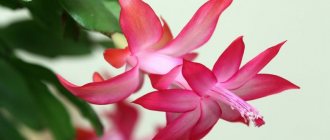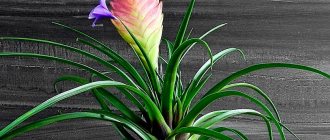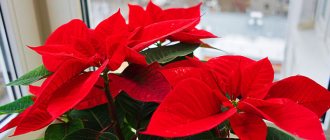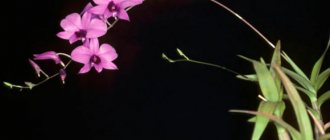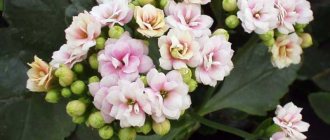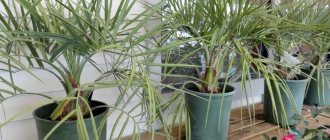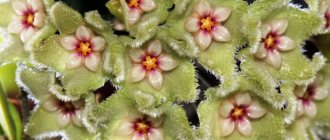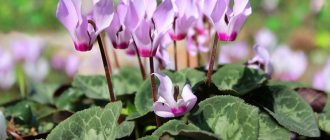Cyclamen is an incredibly beautiful plant that lifts your spirits all winter.
Outside the window there is cold and wind, snow and ice, and the “green pet” is blooming delicate buds. It’s not for nothing that it is most often called the flower of happiness! Its popularity is growing every year, and not only because of its beauty, but also because it is a winter bloomer. Most flowers “sleep” at this time of year, but cyclamen, on the contrary, delights with a riot of flowering and does not require serious care at home.
Compact leaves of ideal shape, surprising with the variety of patterns on them. And the flowers can be compared to butterflies, located on stems rising above the foliage.
general characteristics
Indoor flowers Cyclamens are perennials, and therefore require more detailed care. The flower description includes several of the following parameters:
- The ground part is represented by oblong green leaves. On the surface of each leaf there is usually a silvery pattern.
- Flowers are presented in the form of single inflorescences, which are located on long thin “legs”.
When replanting, you will notice that the root system of the plant is tuberous and very powerfully developed. The flowering period can occur in winter or spring, which is determined by the type of indoor crop.
Forest flowers of Siberia
Kandyk, erythronium (ERYTHRONIUM). Lily family.
A bulbous plant (25 species are known in the forests of Europe, Siberia and North America) with fragile oblong bulbs, two basal oval spotted leaves and a low (10-20 cm) peduncle bearing a drooping single flower with leaves bent to the sides and upwards. A typical ephemeral plant that blooms in spring and loses its leaves in late spring.
Types and varieties. Most often grown:
American Kandyk (E. americanum) - with small whitish flowers.
Caucasian Kandyk (E. caucasicum) - large, creamy flowers with red spots inside.
Siberian Kandyk (E. sibiricum) - pinkish-violet flowers.
Dog's tooth or European candyk (E. denscanis) - pink flowers, 20 cm in diameter.
Japanese Kandyk (E. japonicum) is a pink-purple, narrow flower.
Hybrid Kandyk (E. x hybridum) - a wonderful variety "Pagoda" - flower diameter 30 cm.
Growing conditions. Shaded and semi-shaded places with rich, moderately moist, loose soils.
Reproduction. By seeds (sowing in June-July only with freshly harvested seeds), baby bulbs (at the end of August). Planting density - 25 pcs. per 1 m2.
Bergenia (BERGENIA). Family of Saxifragas.
A beautiful decorative foliage plant, about 10 species of which grow on rocks in the forest belt of the mountains of Siberia and East Asia. These are low-growing (25-35 cm) herbs with a thick rhizome and dense, leathery, usually evergreen leaves. They bloom in early spring, the flowers are small, bell-shaped, in a dense racemose inflorescence.
Types and varieties:
Heart-leaved bergenia (B. cordifolia) - height 40 cm and thick-leaved bergenia (B. crassifolia) - height 30 cm.
Delavay's bergenia (B. delavayi) - height 20 cm and Himalayan (B. hymalaica = B. ligulata) - height 30 cm, leaves are smaller.
Pacific bergenia (B. pacifica) - leaves do not overwinter.
There is a group of hybrids with flowers ranging in color from white to dark red and leaves of different sizes:
“Abendglut” - leaves turn bronze; "Silberlicht" - leaves with silver spots, white flowers.
"Purpurea" has dark purple leaves.
Growing conditions. Semi-shaded and shady areas with loose, rocky, well-drained poor soils. Does not tolerate stagnant moisture, responds well to mulching with an inert layer.
Reproduction. Seeds (sowing before winter) and sections of rhizomes (at the end of summer). Planting density - 7 pcs. per 1 m2.
This beautiful, undemanding plant can be used in flower beds of various styles - in group plantings, mixborders, large tracts, in borders, on rockeries.
The thick dark brown rhizome of bergenia should be located near the surface of the soil; if buried, rotting is possible.
These forest flowers of Siberia and East Asia are used in mixed flower beds and mixborders in the foreground in combination with other drought-resistant plants (wormwood, monarda, coreopsis, heuchera, etc.). In rockeries and single plantings against the background of an inert layer.
Lighting requirements
There are several important features in growing the cyclamen plant. For active flowering, the plant needs sunlight, but excess direct sunlight can cause burns and death of the crop.
The most optimal place for placing a flower pot is a window sill on the western or eastern side of the house, where a large amount of diffused light enters.
Temperature
Unlike most indoor plants, this representative prefers slight coolness, which should be taken into account when caring for it at home. The healthiest growth of a lush crown and the development of a beautiful inflorescence can be observed only at air temperatures in the range of 10-15 degrees. In the summer season, cyclamen can tolerate temperatures up to 25 degrees, but with regular ventilation of the room.
Variegated violet in the garden
Forms a rosette of leaves up to 15 cm high, without shoots. The leaves are dense, kidney-shaped, 2.5-5 cm long, pubescent, dark green on top with silver veins, purple underneath.
Growing conditions. In nature it grows on dry slopes, steep cliffs, and dry steppes. In the garden, variegated violet requires bright, dry places with good drainage from fine crushed stone.
Use: Rockeries, alpine slides.
Varieties of variegated violets in the photo with descriptions:
"Syletta" - often sold under the name "cyclamenolifolia violet", has bright veins on the leaf blades.
Violet variety "Sylvia Hart" - with bright silvery veins on the leaves.
Organization of optimal watering
For proper growth and development, as well as disease prevention, watering must be optimally organized. How to water a flower:
- Water intended for irrigation is preliminarily settled for several days.
- It is important to ensure that the water temperature remains at 16-18 degrees.
- The most abundant watering should be during the flowering of cyclamen.
- In organizing care, it is necessary to find a “golden mean”: moisture should not stagnate in the flower pot, but the plant does not tolerate drought well.
An excellent solution for growing at home would be to carry out bottom watering through a tray. With this approach, water does not come into direct contact with the root and above-ground part of the plant.
Cyclamen loves high air humidity, so experts recommend spraying the bush with a spray bottle. However, this technique is used only before flowering, and then the pebbles are moistened in a tray.
Landing
Cyclamen, like any indoor plant, has its own characteristics of choosing the time of planting and preparing for it.
Preparation
Plant corms must be planted and replanted during their dormant period, the optimal time being May - June. If you purchased a flowering plant, you need to wait until the end of the flowering period. If planted as a separate tuber, it is considered to be in a dormant state.
Soil and pot
If ready-made soil is used, then buy either one specialized for these plants or soil for Saintpaulias. They also make their own soil from equal parts of turf soil, leaf soil, humus and sand. You should get loose soil with an acidity of 5.5 - 6.5.
Another option for soil mixture is mixed in equal parts:
- peat;
- leaf soil;
- sand;
- agroperlite
We talked in more detail about how to choose soil for cyclamen and prepare it yourself in this article.
Before planting, the soil is heated in a closet or treated with a solution of potassium permanganate.
On a note. The size of the pot depends on the age and size of the tuber being planted. It is recommended to first try it on the pot; the distance between it and the walls should be about 3 cm.
If the distance is significantly greater, then problems with flowering are possible in the future. The pot should not be too high, and the soil in it should not be saturated with excess moisture. A drainage hole of at least 1.5 cm in diameter is required.
Before planting, you need to decide on which side of the corm the leaf buds are located. They look like small, protruding pimples, concentrated together - this is called the growth zone and cyclamen has one.
If this is difficult to do, then place the tuber on damp moss and wait for the buds to sprout. There are options for planting sideways, without defining the top and bottom.
Step-by-step instruction
- Drainage (expanded clay, pebbles, broken brick) is poured into the bottom of the pot.
- Fill in most of the soil prepared for planting and lightly compress it. The soil cannot be compacted due to reduced air permeability.
The tuber is placed in a pot and soil is added until it covers two-thirds of it.
If accelerated leaf growth is required, then the root is completely covered (the top layer of soil should be thin). Gardeners prefer to leave a third of the root free from soil. This reduces the risk of injury to the growth zone and provides access to air and light to the tuber.With excessive deepening, the risk of rotting increases and the number of peduncles with buds decreases. If there is insufficient soil coverage, the tuber will become woody, develop poorly and produce fewer buds.
- After planting, watering is not carried out; it will be necessary after the shoots appear.
Applying fertilizers to the soil
Caring for crops indoors also includes fertilizing. Such a brightly flowering plant undoubtedly requires regular feeding. In practice, universal complex fertilizers are used.
It is important to ensure that the fertilizer does not contain an excess of nitrogen compounds, which lead to rotting of the tubers. During the period of active flowering, all feeding of the flowering crop is completely stopped.
Where is ginger grown and grown?
This is a perennial herbaceous plant with erect stems that loves warmth and sunny color, high levels of humidity in the air and soil.
That is why ginger root grows only in countries that correspond to these climatic conditions:
- Japan;
- Vietnam;
- Africa;
- Australia;
- South America (Argentina, Brazil);
- Jamaica Island.
The widespread spread of the culture began in the eighteenth century, although the first active use was recorded in India already in the ninth century. The homeland was kept secret - in this way merchants increased the value and shrouded the properties in riddles and secrets.
Let's figure out where ginger root grows in nature? The plant has not grown wild for a long time, although the most suitable climate can be found in southern Africa and eastern Asia. The culture grows in industrial areas under the strict control of people:
- On farms;
- On plantations;
- On the fields.
An important requirement is compliance with weather conditions and careful care. There are small farms and huge plantations, some of which have been in operation for more than two hundred years
Almost the entire harvest is exported and distributed around the world, and is also supplied to our country.
Below we will discuss in detail the growth of culture in the Russian Federation. Unfortunately, it is not possible on a large scale - but here are some regions that would theoretically be suitable for growing the spice:
- Krasnodar;
- Crimea;
- Caucasus;
- Moscow region;
- Rostov region.
Care during the dormant period
The indoor plant cyclamen has a dormant period. You can recognize its onset by the drying and complete fall of the leaves. During this period, a number of care rules are followed for the culture:
- Reduce the frequency and volume of watering.
- Arrange regular ventilation of the room with the flower.
- When placing the pot in a bright room, transfer the plant to a shaded place, deprived of bright natural light.
Sometimes another technique is used. After the leaves have completely fallen off, the flower pot is turned 90 degrees and stored in this position until the buds appear.
Diseases and pests
In order for a butterfly flower to enjoy a long period of flowering, it needs to be provided with regular and proper care. And if certain rules are not followed, the bush is susceptible to the development of diseases and the appearance of pests. If everything is left to chance, he will simply die.
The leaves are turning yellow
Why do the leaves turn yellow and what to do? Many gardeners are faced with this problem, which develops due to dry air in the room , irregular watering and spraying, and high temperature. Also, cyclamen can turn yellow if it is placed on a windowsill in direct sunlight, then burns appear on the leaves.
The leaves are curling
The first is that if an exotic beauty is standing in the sun, then it must be moved to a shaded place and fed. The second reason why leaves curl is the appearance of a mite. You can identify it by specks on the back of the leaf and a coating similar to a dusty layer - they need to be unscrewed and the plant treated with chemical acaricides.
Why does it wither?
If the bush is actively developing and during this period begins to turn yellow, then this is a pathology.
There may be several reasons: the temperature regime has changed abruptly; humidity is insufficient or, conversely, excess; he got sunburn; the composition of the substrate is depleted, there is a deficiency of nutrients. What should a gardener do if the cyclamen withers? First of all, check the health of the tuber. If it is soft, then cyclamen cannot be helped - it is dead. If it's hard, you can still fix it. And secondly, provide the bush with all proper care measures.
Why doesn't it bloom?
Requires a rest period in summer. The “Flower of Happiness” does not please with its bright and lush flowering in winter, if it was not provided with a period of rest in the summer. It should be remembered that cyclamen blooms only in cool conditions and with high levels of humidity.
The reason for not flowering is also overfeeding.
You shouldn't expect buds from poor lighting in the evening, especially in winter. It is necessary to provide additional, artificial lighting.
Having ensured optimal humidity in the room, systematized proper watering and removed the pot from the hot room, and soon the primrose will begin to delight with delicate buds.
Aphid
This pest not only destroys shrubs, but also infects neighboring ones. Aphids are insects that suck juice from soft tissues, leaving a sticky bluish coating on the surface. The procedure for treating the trunk and foliage with insecticidal solutions will help drive away the pest and improve the health of the bush .
The tuber is rotting
Increased humidity. In this case, the tuber was damaged by non-infectious rot. If you feel it, it will not be soft completely, but only in places. A putrid odor will be felt and brown spots will be visible. If you open one of the spots with a knife, you can see whitish rot inside. Bacteria, infecting healthy areas of the tuber, can re-infect already diseased areas. If infected tubers are dried, the rot will disappear, leaving only brown spots and voids.
Expert opinion
Vera Ivanovna Sh
Since childhood, I have been interested in growing indoor flowers, then I decided to devote my life to landscape design and gardening.
What to do? Remove diseased tubers, and additionally fertilize healthy ones, adjust the pH of the substrate; at high temperatures, reduce the level of humidity and watering; When planting and replanting, do not bury the seeds too deeply.
The leaves turned bronze
Thrips are to blame. This virus disfigures the plant: the leaves lose their beautiful shape, veins, and tissue near the petiole become covered with necrosis, and the petals of the buds become variegated. And the virus begins with the first symptom - the leaves are covered with a brown pattern, like an oak tree .
What should a florist do? Unscrew diseased foliage. Hang sticky blue thrip traps.
A ring pattern appeared
The virus has spread thrips.
The virus can be recognized by such a symptom as a ring pattern on the foliage, like human fingerprints. The leaf veins become wooden, cracks appear, the bush stops growing, then withers and dies. Get rid of the virus using the same method as the bronze disease. The method is the same: unscrew the diseased specimens and hang sticky traps.
The bush has become empty
The disease is called Anthracnose. This is when a void forms in the center of the bush. The shrub does not form new stems, leaves or buds. And the young ones, recently grown, become thin, withered and brown.
You can help your pet like this: inspect the seedlings before planting, and at the first sign of illness, treat the bush with biological products that fight gray mold of flowering plants.
The plant does not grow
Nematodes are to blame. If the pet has stopped growing at all, and swellings are visible on its roots, which are very similar to beads. Nematodes have settled in these nodules. They can be expelled if the affected roots are destroyed. Then in a pot, in open soil, reduce the planting density.
The foliage has become rough to the touch
The multi-clawed mite is to blame.
The leaves became coarser, lost their rounded shape, and the stalks were covered with scabs. The buds are covered entirely with whitish seals. The primrose needs to be urgently inspected and severely affected areas of the plant must be destroyed . You can leave specimens less affected by the disease and carry out the treatment procedure with a solution of laundry soap or wipe with mineral oil.
Larvae have appeared, what should I do?
If a fungus gnat has colonized the soil in a pot, it can be recognized by glass larvae 1 mm in size. The larvae feed on roots. And they will be destroyed by the drug Fly Eater or Thunder, with which the soil must be treated.
If you follow all the rules for caring for the alpine violet, then growing a healthy, strong, beautiful and wildly blooming flower will not be difficult even for a novice gardener.
How to transplant cyclamen
One of the most important practical issues in caring for cyclamen is how to replant. Irrational replanting of an indoor flower can lead to mechanical damage to the root system, as well as to the death of the plant.
The correct sequence for transplantation is:
- This procedure is carried out every year in the last month of summer.
- The new flower pot should be wide enough so that the roots are not compressed.
- The prepared container is filled with slightly alkaline soil.
- It is important to organize a high-quality drainage layer (this can be expanded clay, pebbles).
- The composition of the nutrient soil must necessarily include peat, sand, and humus in the optimal ratio.
- The plant is carefully removed from the old pot, being careful not to damage the roots.
- The tubers are carefully examined, rotting and painful areas are removed using scissors.
- When planting tubers, it is better to leave the roots protruding one third above the soil surface. This approach contributes to more luxuriant flowering of the bush.
The buried roots are sprinkled with prepared soil and watered with settled water.
Use in folk medicine
In folk medicine, attention has been paid to cyclamen root for a long time. Healing juice is extracted from the tubers, which can be rubbed into areas of the body and quickly relieve pain. Excellent for joint pain and rheumatism.
Many claim that juice from cyclamen tubers restores the menstrual cycle and also strengthens potency. It also has a positive effect on infertility.
Cyclamen is used for the following ailments:
- Immune system disorder.
- Diabetes mellitus.
- Chronic allergies.
- Diseases of the genitourinary system.
- Hair loss.
- Hemorrhoids.
- Snake bites and various food poisonings.
Over the years, traditional medicine has proven the healing benefits of this plant.
We talked in detail about the medicinal and beneficial properties of cyclamen, its chemical composition, as well as contraindications to its use in this article.
Growing cyclamen from seeds
Most often, cyclamen is purchased at a houseplant store. However, if you wish, you can grow a flower crop from seeds at home. For high-quality and healthy growth, it is better to purchase planting material in a specialized store. Step-by-step growing a plant from seeds:
- The finished seeds are immersed in a sugar solution. Remove the seeds that float to the surface.
- The further task is to soak the seed material in a growth stimulant solution.
- Seeds are placed in the top layer of prepared soil and sprinkled with a thin layer of soil.
- The container with the planted seeds is covered with glass or wrapped in plastic wrap.
- After the first shoots appear (after about 45 days), the container with the plants is removed to a cool place with diffused light.
- At the stage of 2-3 leaves, they are picked into separate pots.
- After a week, young seedlings must be fed with universal fertilizer.
Plants are transplanted into permanent flower pots in the last days of spring. With proper care, flowering is observed after 15 months of bush growth.
Cyclamen: features and types of plants
The homeland of cyclamen is considered to be the Mediterranean, Central Europe, and Central Asia. Some species have been spotted in the Caucasus and Crimea, but the classic version of the flower was brought precisely from Europe. The indoor version of the plant is more common than its garden counterpart, which is explained by both climatic problems and the general intractability of cyclamen in unusual conditions.
The popularity of the lovely flowering plant, cyclamen, has only increased over the years.
FACT! Cyclamen has been known to mankind since the times of Ancient Rome, when it was used as a decoration for home and yard , and as a remedy, and as a protective amulet (for example, to successfully complete a pregnancy, you should carry a cyclamen flower with you).
Two types are common in indoor cultivation: Persian cyclamen and European cyclamen
To choose the ideal option for specific conditions, you should know all types of indoor cyclamens or have a general understanding of the features of caring for them. The most common are two types: Persian and European, but besides them, subspecies such as Lebanese, ivy-leaved, Cretan, amazing, as well as cyclamen intaminetum also appear in specialized literature.
An exquisite plant, familiar to most lovers of exotic flora as the Alpine violet, has a proud scientific name - cyclamen
- It is the Persian cyclamen that is considered one of the most common types of indoor and garden plants, since it is distinguished by large flowers and leaves, so attractive to the average person. Leaves up to 14 cm in diameter and more than a hundred flowers on one tuber in one season make it an ideal plant for the garden and home. Juicy, fleshy emerald leaves with a subtle silver pattern provide the perfect backdrop for graceful and airy flowers reminiscent of the fluttering wings of an exotic butterfly.
The undoubted advantage of Persian cyclamen is that it blooms in winter, when there are not many flowering plants
- European cyclamen is a rare guest not only in the collections of flora lovers, but also in specialized stores. Not too large and inexpressive flowers of exclusively pink color are not very attractive to ordinary people, although the juicy and pleasant smell of this plant is a worthy substitute for external attractiveness. Long flowering - from May until the end of September - is possible with

